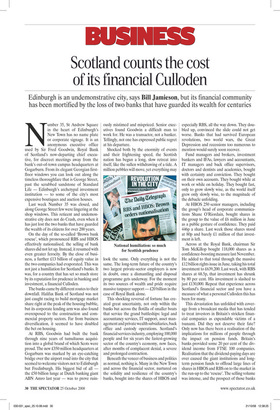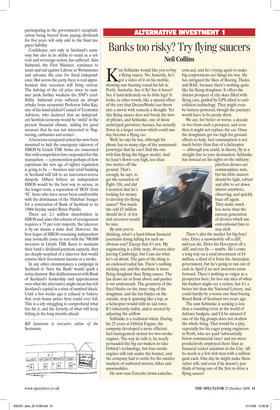Scotland counts the cost of its financial Culloden
Edinburgh is an undemonstrative city, says Bill Jamieson, but its financial community has been mortified by the loss of two banks that have guarded its wealth for centuries Number 35, St Andrew Square in the heart of Edinburgh’s New Town has no name plate or corporate signage. It is an anonymous executive office used by Sir Fred Goodwin, Royal Bank of Scotland’s now-departing chief executive, for discreet meetings away from the bank’s out-of-town campus headquarters at Gogarburn. From its elegant Georgian firstfloor windows you can look out along the timeless thoroughfare that is George Street, past the scrubbed sandstone of Standard Life — Edinburgh’s archetypal investment institution — to some of the city’s most expensive boutiques and auction houses.
Last week Number 35 was closed, and along George Street few were lingering at the shop windows. This reticent and undemonstrative city does not do Crash, even when it has just lost the two banks that have guarded the wealth of its citizens for over 200 years.
On the day of the so-called ‘Brown bank rescue’, which pronounced RBS and HBOS effectively nationalised, the selling of bank shares did not let up. Instead, it resumed with even greater ferocity. By the close of business, a further £13 billion of equity value in the two companies had evaporated. This was not just a humiliation for Scotland’s banks. It was, for a country that has set so much store by its reputation for prudence in banking and investment, a financial Culloden.
The banks came by different routes to their downfall. Halifax Bank of Scotland was not just caught racing to build mortgage market share right at the peak of the housing bubble, but its corporate lending arm was also found overexposed to the construction and commercial property sectors. Far from business diversification, it seemed to have doubled the bet on housing.
At RBS, Goodwin had built the bank through nine years of tumultuous acquisition into a global brand of which Scots were proud. The new £350 million headquarters at Gogarburn was marked by an eye-catching bridge over the airport road into the city that seemed to welcome visitors not to Edinburgh but Fredinburgh. His biggest bid of all — the £50 billion lunge at Dutch banking giant ABN Amro last year — was to prove ruin ously mistimed and mispriced. Senior executives found Goodwin a difficult man to work for. He was a transactor, not a banker. Tellingly, not one has expressed public regret at his departure.
Shocked both by the enormity of events and their frightening speed, the Scottish nation has begun a long, slow retreat into itself, like the sullen withdrawing of a tide. A million pebbles will move, yet everything may look the same. Only everything is not the same. The long-term future of the country’s two largest private-sector employers is now in doubt, once a dismantling and disposal programme gets underway. For the moment its two sources of wealth and pride require massive taxpayer support — £20 billion in the case of Royal Bank alone.
This shocking reversal of fortune has created great uncertainty, not only within the banks but across the flotilla of smaller boats that service the grand battleships: legal and accountancy services, IT support, asset management and private wealth subsidiaries, back office and custody operations. Scotland’s financial services industry, employing 100,000 people and for six years the fastest-growing sector of the country’s economy, now faces, after months of complacent denial, a severe and prolonged contraction.
Beneath the veneer of business and politics as normal, nothing is. Many in the New Town and across the financial sector, nurtured on the solidity and resilience of the country’s banks, bought into the shares of HBOS and especially RBS, all the way down. They doubled up, convinced the slide could not get worse. Banks that had survived European revolutions, two world wars, the Great Depression and recessions too numerous to mention would surely soon recover.
Fund managers and brokers, investment bankers and IFAs, lawyers and accountants, IT managers and back office supervisors, doctors and dentists and academics, bought with certainty and conviction. They bought on their own accounts. They bought while at work or while on holiday. They bought fast, only to grow slowly wise, as the world itself grew only slowly wise, to the magnitude of the debacle unfolding.
At HBOS 250 senior managers, including the group’s head of corporate communications Shane O’Riordain, bought shares in the group to the value of £6 million in June as a public gesture of confidence. They paid 446p a share. Last week those shares stood at 80p and barely £1 million of that investment is left.
Across at the Royal Bank, chairman Sir Tom McKillop bought 118,000 shares as a confidence-boosting measure last November. He added to that total through the massive £12 billion rights issue in June, taking his total investment to £639,200. Last week, with RBS shares at 68.5p, that investment has shrunk by 80 per cent. His investment is slashed to just £130,000. Repeat that experience across Scotland’s financial sector and you have a measure of what a personal Culloden this has been for many.
This devastation has unfolded with coverage from a broadcast media that has tended to treat investors in Britain’s stricken financial companies as expendable victims of a tsunami. Did they not deserve their fate? Only now has there been a realisation of the implications for millions of people through the impact on pension funds. Britain’s banks provided some 20 per cent of the dividend income from FTSE 100 companies. Realisation that the dividend-paying days are over caused the giant institutions and longterm pension funds to offload large lines of shares in HBOS and RBS on to the market in the run-up to the ‘rescue’. The selling volume was intense, and the prospect of those banks participating in the government’s recapitalisation being barred from paying dividends for five years will only add to the final taxpayer liability.
Confidence, not only in Scotland’s economy but also in its ability to stand as a solvent and sovereign nation, has suffered. Alex Salmond, the First Minister, continues to taunt and rail against Labour at Westminster and advance the case for fiscal independence. But across the party there is real apprehension that recession will bring retreat. The halving of the oil price since its summer peak further weakens the SNP’s credibility. Salmond even suffered an abrupt rebuke from economist Professor John Kay, one of his hand-picked Council of Economic Advisers, who declared that an independent Scottish economy would be ‘awful’ in the present financial climate, adding for good measure that he was not interested in ‘flagwaving, embassies and armies’.
A ferocious rearguard action has now been mounted to halt the emergency takeover of HBOS by Lloyds TSB. Some are concerned that with competition laws suspended for this transaction — a premonition perhaps of how capricious the new age of tighter regulation is going to be — business and retail banking in Scotland will fall to an innovation-averse duopoly. Others believe an independent HBOS would be the best way to secure, in the longer term, a separation of ‘BOS’ from ‘H’. Scots who have never been comfortable with the dominance of the ‘Haleban’ hunger for a restoration of Bank of Scotland to its 1980s heyday under Bruce Patullo.
There are 2.1 million shareholders in HBOS and, since this scheme of arrangement requires a 75 per cent majority, the takeover is by no means a done deal. However, the best hopes of HBOS remaining independent may ironically come to rest with the 700,000 investors in Lloyds TSB. Keen to maintain their bank’s dividend-payment capacity, they are deeply sceptical of a takeover that would remove their investment income at a stroke.
In any other circumstances a campaign in Scotland to ‘Save the Bank’ would spark a noisy clamour. But disillusionment with Bank of Scotland’s leadership and apprehension over what the alternative might mean has left Scotland’s capital in a state of numbed shock. Until a few weeks ago it refused to believe that even house prices here could ever fall. This is a city struggling to comprehend what has hit it, and the ferocity of what will keep hitting in the long months ahead.
Bill Jamieson is executive editor of the Scotsman.



















































































 Previous page
Previous page